Forest Aboveground Biomass Estimation Using Multi-Features Extracted by Fitting Vertical Backscattered Power Profile of Tomographic SAR
Abstract
1. Introduction
2. Materials and Methods
2.1. Study Area and Data Set
2.2. Framework of Research
2.3. TomoSAR Data Processing and Tomographic Imaging Algorithm
2.3.1. Ground Phase Removal
2.3.2. Tomographic Imaging
2.3.3. Terrain Compensation
2.4. Feature Extraction of Forest Vertical Profile Based on TomoSAR
2.4.1. Main Factors Affecting Forest AGB at a Sample Plot Scale
2.4.2. Fitting of Backscattered Power Curve and Features Extraction
- In the horizontal dimension of the ground geometry, which we called (x, y) plane, the parameterized samples of TomoSAR vertical profile were selected according to sub sample plot position recorded by the field survey. In this paper, 85 sub sample plots were used, including 25 sub sample plots of size 100 × 100 m and 60 sub sample plots of size 125 × 125 m. The sizes of sub sample plots were about the same as four multilook cells, and each sub sample plot (100 × 100 m or 125 × 125 m) corresponded to a backscattered power curve.
- In the vertical dimension of ground geometry, on the z axis of spatial rectangular coordinate system, the height range of 0–40 m was sampled at an interval of 1 m, with a total of 40 sampling height layers.
- At the sampling height layers determined in (2), the backscattered power of the TomoSAR vertical profile was sampled, so the backscattered power mean values in the height range of 0–40 m (1 m interval) were obtained for each of the 85 sub sample plots.
- Because some features’ calculation needs to convert the discrete backscattered power value into continuous power curve, such as the LBPC and BPFAH, the backscattered power mean value of each sample in the vertical direction was fitted using the Gaussian Mixture Model [4,18]. The fitting performance was evaluated by fit goodness, and R-square of backscattered power curve fitting in all sub sample plots were above 0.98. Finally, we obtained the backscattered power curves of 85 sample points ranging from 0 to 40 m.
- Based on the difference between DTM and DSM products [7,38], we averaged the forest height of the 85 samples. The backscattered power curve of vertical dimension was limited according to the average forest height. Then the backscattered power curve of TomoSAR vertical profile within the range of forest height was obtained.
- Based on the backscattered power curve fitted in (5), the features of TomoSAR vertical profiles were extracted. The features included the LBPC, the BPV of the TomoSAR at intervals of 1 m within the range of forest height, the BPFAH and the FAH. The definitions of these proposed features were listed in Table 3.
2.5. Forest AGB Estimation and Accuracy Validation
3. Results
3.1. TomoSAR Data Processing
3.1.1. The Effectiveness of Terrain Topography Estimation and Terrain Compensation
3.1.2. Tomographic SAR Imaging
3.2. Analysis of the Relationship between Profile Features and Forest AGB
3.2.1. Backscattered Power Curve Fitting Results and Their Characteristics in Different AGB Levels
3.2.2. Analyzing the Sensitivity of the Profile Features to Forest AGB
3.2.3. Accuracy Validation
4. Discussion
5. Conclusions
Author Contributions
Funding
Acknowledgments
Conflicts of Interest
References
- Galbraith, D.; Levy, P.E.; Sitch, S.; Huntingford, C.; Cox, P.; Williams, M.; Meir, P. Multiple mechanisms of Amazonian forest biomass losses in three dynamic global vegetation models under climate change. New Phytol. 2010, 187, 647–665. [Google Scholar] [CrossRef] [PubMed]
- Köhl, M.; Lasco, R.D.; Cifuentes, M.; Jonsson, Ö.; Korhonen, K.; Mundhenk, P.; Návar, J.; Stinson, G. Changes in forest production, biomass and carbon: Results from the 2015 UN FAO Global Forest Resource Assessment. For. Ecol. Manag. 2015, 352, 21–34. [Google Scholar] [CrossRef]
- Reich, P.B.; Luo, Y.; Bradford, J.B.; Poorter, H.; Perry, C.H.; Oleksyn, J. Temperature drives global patterns in forest biomass distribution in leaves, stems, and roots. Proc. Natl. Acad. Sci. USA 2014, 111, 13721–13726. [Google Scholar] [CrossRef] [PubMed]
- Li, W.; Chen, E.; Li, Z.; Ke, Y.; Zhan, W. Forest aboveground biomass estimation using polarization coherence tomography and PolSAR segmentation. Int. J. Remote Sens. 2015, 36, 530–550. [Google Scholar] [CrossRef]
- Rodríguez-Veiga, P.; Quegan, S.; Carreiras, J.M.; Persson, H.J.; Fransson, J.E.; Hoscilo, A.; Ziółkowski, D.; Stereńczak, K.; Lohberger, S.; Stängel, M.; et al. Forest biomass retrieval approaches from earth observation in different biomes. Int. J. Appl. Earth Obs. Geoinf. 2019, 77, 53–68. [Google Scholar] [CrossRef]
- Gu, C.; Clevers, J.G.; Liu, X.; Tian, X.; Li, Z.; Li, Z. Predicting forest height using the GOST, Landsat 7 ETM+, and airborne LiDAR for sloping terrains in the Greater Khingan Mountains of China. ISPRS J. Photogramm. Remote Sens. 2018, 137, 97–111. [Google Scholar] [CrossRef]
- Li, L.; Chen, E.; Li, Z.; Zhao, L.; Gu, X. Forest above ground biomass estimation from P-band tomography data. In Proceedings of the 2016 IEEE International Geoscience and Remote Sensing Symposium (IGARSS), Beijing, China, 10–15 July 2016; IEEE: Piscataway, NJ, USA, 2016; pp. 21–23. [Google Scholar] [CrossRef]
- Luo, H.; Chen, E.; Cheng, J.; Li, X. Tree height retrieval methods using POLInSAR coherence optimization. In Proceedings of the 2010 IEEE International Geoscience and Remote Sensing Symposium, Honolulu, HI, USA, 25–30 July 2010; IEEE: Piscataway, NJ, USA, 2010; pp. 3259–3262. [Google Scholar]
- Cutler, M.E.J.; Boyd, D.S.; Foody, G.M.; Vetrivel, A. Estimating tropical forest biomass with a combination of SAR image texture and Landsat TM data: An assessment of predictions between regions. ISPRS J. Photogramm. Remote Sens. 2012, 70, 66–77. [Google Scholar] [CrossRef]
- Luckman, A. A study of the relationship between radar backscatter and regenerating tropical forest biomass for spaceborne SAR instruments. Remote Sens. Environ. 1997, 60, 1–13. [Google Scholar] [CrossRef]
- Mette, T.; Papathanassiou, K.P.; Hajnsek, I.; Zimmermann, R. Forest biomass estimation using polarimetric SAR interfer-ometry. In Proceedings of the International Geoscience and Remote Sensing Symposium, Toronto, ON, Canada, 24–28 June 2002; IEEE: Piscataway, NJ, USA, 2002; pp. 817–819. [Google Scholar]
- Dobson, M.; Ulaby, F.; LeToan, T.; Beaudoin, A.; Kasischke, E.; Christensen, N. Dependence of radar backscatter on coniferous forest biomass. IEEE Trans. Geosci. Remote Sens. 1992, 30, 412–415. [Google Scholar] [CrossRef]
- Soja, M.J.; Sandberg, G.; Ulander, L.M.H. Regression-Based Retrieval of Boreal Forest Biomass in Sloping Terrain Using P-Band SAR Backscatter Intensity Data. IEEE Trans. Geosci. Remote Sens. 2013, 51, 2646–2665. [Google Scholar] [CrossRef]
- Le Toan, T.; Beaudoin, A.; Riom, J.; Guyon, D. Relating forest biomass to SAR data. IEEE Trans. Geosci. Remote Sens. 1992, 30, 403–411. [Google Scholar] [CrossRef]
- Le Toan, T.; Quegan, S.; Woodward, I.; Lomas, M.; Delbart, N.; Picard, G. Relating Radar Remote Sensing of Biomass to Modelling of Forest Carbon Budgets. Clim. Chang. 2004, 67, 379–402. [Google Scholar] [CrossRef]
- Kumar, S.; Khati, U.; Chandola, S.; Agrawal, S.; Kushwaha, S.P. Polarimetric SAR Interferometry based modeling for tree height and aboveground biomass retrieval in a tropical deciduous forest. Adv. Space Res. 2017, 60, 571–586. [Google Scholar] [CrossRef]
- Li, W.; Chen, E.; Li, Z.; Luo, H.; Zhou, W.; Feng, Q.; Wang, X. Combing Polarization coherence tomography and PoLInSAR segmentation for forest above ground biomass estimation. In Proceedings of the 2012 IEEE International Geoscience and Remote Sensing Symposium, Munich, Germany, 22–27 July 2012; IEEE: Piscataway, NJ, USA, 2012; pp. 3351–3354. [Google Scholar]
- Luo, H.; Li, X.W.; Chen, E.; Cheng, J.; Cao, C. Analysis of forest backscattering characteristics based on polarization coherence tomography. Sci. China Ser. E Technol. Sci. 2010, 53, 166–175. [Google Scholar] [CrossRef]
- Behera, M.D.; Tripathi, P.; Mishra, B.; Kumar, S.; Chitale, V.; Behera, S.K. Above-ground biomass and carbon estimates of Shorea robusta and Tectona grandis forests using QuadPOL ALOS PALSAR data. Adv. Space Res. 2016, 57, 552–561. [Google Scholar] [CrossRef]
- Cartus, O.; Santoro, M.; Schmullius, C.; Li, Z. Large area forest stem volume mapping in the boreal zone using synergy of ERS-1/2 tandem coherence and MODIS vegetation continuous fields. Remote Sens. Environ. 2011, 115, 931–943. [Google Scholar] [CrossRef]
- Fransson, J.E.S.; Smith, G.; Askne, J.; Olsson, H. Stem volume estimation in boreal forests using ERS-1/2 coherence and SPOT XS optical data. Int. J. Remote Sens. 2001, 22, 2777–2791. [Google Scholar] [CrossRef]
- Pulliainen, J.; Heiska, K.; Hyyppa, J.; Hallikainen, M. Backscattering properties of boreal forests at the C- and X-bands. IEEE Trans. Geosci. Remote Sens. 1994, 32, 1041–1050. [Google Scholar] [CrossRef]
- Solberg, S.; Hansen, E.H.; Gobakken, T.; Næssset, E.; Zahabu, E. Biomass and InSAR height relationship in a dense tropical forest. Remote Sens. Environ. 2017, 192, 166–175. [Google Scholar] [CrossRef]
- Martín-Del-Campo-Becerra, G.D.; Nannini, M.; Reigber, A. Towards Feature Enhanced SAR Tomography: A Maximum-Likelihood Inspired Approach. IEEE Geosci. Remote Sens. Lett. 2018, 15, 1730–1734. [Google Scholar] [CrossRef]
- Cazcarra-Bes, V.; Pardini, M.; Tello, M.; Papathanassiou, K.P. Comparison of Tomographic SAR Reflectivity Reconstruction Algorithms for Forest Applications at L-band. IEEE Trans. Geosci. Remote Sens. 2020, 58, 147–164. [Google Scholar] [CrossRef]
- Cloude, S.R. Polarization coherence tomography. Radio Sci. 2006, 41, 1–27. [Google Scholar] [CrossRef]
- D’Alessandro, M.M.; Tebaldini, S.; Rocca, F. Phenomenology of Ground Scattering in a Tropical Forest Through Polarimetric Synthetic Aperture Radar Tomography. IEEE Trans. Geosci. Remote Sens. 2013, 51, 4430–4437. [Google Scholar] [CrossRef]
- Minh, D.H.T.; Le Toan, T.; Rocca, F.; Tebaldini, S.; D’Alessandro, M.M.; Villard, L. Relating P-Band Synthetic Aperture Radar Tomography to Tropical Forest Biomass. IEEE Trans. Geosci. Remote Sens. 2013, 52, 967–979. [Google Scholar] [CrossRef]
- Minh, D.H.T.; Le Toan, T.; Rocca, F.; Tebaldini, S.; Villard, L.; Réjou-Méchain, M.; Phillips, O.L.; Feldpausch, T.R.; Dubois-Fernandez, P.; Scipal, K.; et al. SAR tomography for the retrieval of forest biomass and height: Cross-validation at two tropical forest sites in French Guiana. Remote Sens. Environ. 2016, 175, 138–147. [Google Scholar] [CrossRef]
- Minh, D.H.T.; Villard, L.; Ferro-Famil, L.; Tebaldini, S.; Le Toan, T. P-Band SAR tomography for the characterization of tropical forests. In Proceedings of the 2017 IEEE International Geoscience and Remote Sensing Symposium (IGARSS), Fort Worth, TX, USA, 23–28 July 2017; IEEE: Piscataway, NJ, USA, 2017; pp. 5862–5865. [Google Scholar]
- Ngo, Y.-N.; Minh, D.H.T.; Moussawi, I.; Villard, L.; Ferro-Famil, L.; D’Alessandro, M.M.; Tebaldini, S.; Albinetv, C.; Scipal, K.; Le Toan, T. Afrisar-Tropisar: Forest Biomass Retrieval by P-Band Sar Tomography. In Proceedings of the IGARSS 2018—2018 IEEE International Geoscience and Remote Sensing Symposium, Valencia, Spain, 22–27 July 2018; IEEE: Piscataway, NJ, USA, 2018; pp. 8675–8678. [Google Scholar]
- Saatchi, S.; White, L.; Ramachandran, N.; Tebaldini, S.; Quegan, S.; Le Toan, T.; Papathanassiou, K.; Chave, J.; Shugart, H.; Jeffery, K. Estimation of Tropical Forest Structure and Biomass from Airborne P-band Backscatter and TomoSAR Measurements. In Proceedings of the IGARSS 2019—2019 IEEE International Geoscience and Remote Sensing Symposium, Yokohama, Japan, 28 July–2 August 2019; IEEE: Piscataway, NJ, USA, 2019; pp. 6007–6010. [Google Scholar]
- Tebaldini, S.; Minh, D.H.T.; D’Alessandro, M.M.; Villard, L.; Le Toan, T.; Chave, J. The Status of Technologies to Measure Forest Biomass and Structural Properties: State of the Art in SAR Tomography of Tropical Forests. Surv. Geophys. 2019, 40, 779–801. [Google Scholar] [CrossRef]
- Caicoya, A.T.; Pardini, M.; Hajnsek, I.; Papathanassiou, K. Forest Above-Ground Biomass Estimation from Vertical Reflec-tivity Profiles at L-Band. IEEE Geosci. Remote Sens. Lett. 2015, 12, 2379–2383. [Google Scholar] [CrossRef]
- Blomberg, E.; Ferro-Famil, L.; Soja, M.J.; Ulander, L.M.; Tebaldini, S. Forest Biomass Retrieval From L-Band SAR Using Tomographic Ground Backscatter Removal. IEEE Geosci. Remote Sens. Lett. 2018, 15, 1030–1034. [Google Scholar] [CrossRef]
- Dalponte, M.; Frizzera, L.; Gianelle, D. How to map forest structure from aircraft, one tree at a time. Ecol. Evol. 2018, 8, 5611–5618. [Google Scholar] [CrossRef]
- Hernández-Stefanoni, J.; Dupuy, J.M.; Tun-Dzul, F.; May-Pat, F. Influence of landscape structure and stand age on species density and biomass of a tropical dry forest across spatial scales. Landsc. Ecol. 2010, 26, 355–370. [Google Scholar] [CrossRef]
- Li, L. Forest Vertical Information Extraction Based on P-Band SAR Tomography. Ph.D. Thesis, Chinese Academy of Forestry, Beijing, China, 2016. [Google Scholar]
- Technical Assistance for the Development of Airborne SAR and Geophysical Measurements during the TropiSAR 2009 Ex-periment. Available online: https://earth.esa.int/c/document_library/get_file?folderId=21020&name=DLFE-899.pdf (accessed on 1 February 2019).
- Kottek, M.; Grieser, J.; Beck, C.; Rudolf, B.; Rubel, F. World Map of the Köppen-Geiger climate classification updated. Meteorol. Z. 2006, 15, 259–263. [Google Scholar] [CrossRef]
- Li, L.; Chen, E.; Li, Z.; Feng, Q.; Zhao, L.; Yang, W. DEM and DHM reconstruction in tropical forests: Tomographic results at P-band with three flight tracks. In Proceedings of the 2015 IEEE International Geoscience and Remote Sensing Symposium (IGARSS), Milan, Italy, 26–31 July 2015; IEEE: Piscataway, NJ, USA, 2015; pp. 3018–3021. [Google Scholar] [CrossRef]
- Vincent, G.; Sabatier, D.; Blanc, L.; Chave, J.; Weissenbacher, E.; Pelissier, R.; Fonty, E.; Molino, J.F.; Couteron, P. Accuracy of small footprint airborne LiDAR in its predictions of tropical moist forest stand structure. Remote Sens. Environ. 2012, 125, 23–33. [Google Scholar] [CrossRef]
- Chave, J.; Andalo, C.; Brown, S.; Cairns, M.A.; Chambers, J.Q.; Eamus, D.; Fölster, H.; Fromard, F.; Higuchi, N.; Kira, T.; et al. Tree allometry and improved estimation of carbon stocks and balance in tropical forests. Oecologia 2005, 145, 87–99. [Google Scholar] [CrossRef] [PubMed]
- Tebaldini, S. Algebraic Synthesis of Forest Scenarios From Multibaseline PolInSAR Data. IEEE Trans. Geosci. Remote Sens. 2009, 47, 4132–4142. [Google Scholar] [CrossRef]
- Huang, Y.; Ferro-Famil, L.; Reigber, A. Under-Foliage Object Imaging Using SAR Tomography and Polarimetric Spectral Estimators. IEEE Trans. Geosci. Remote Sens. 2012, 50, 2213–2225. [Google Scholar] [CrossRef]
- Pardini, M.; Papathanassiou, K. Sub-canopy topography estimation: Experiments with multibaseline SAR data at L-band. In Proceedings of the 2012 IEEE International Geoscience and Remote Sensing Symposium, Munich, Germany, 22–27 July 2012; IEEE: Piscataway, NJ, USA, 2012; pp. 4954–4957. [Google Scholar]
- Tang, X.; Lu, Y.; Fehrmann, L.; Forrester, D.I.; Guisasola-Rodríguez, R.; Pérez-Cruzado, C.; Kleinn, C. Estimation of stand-level aboveground biomass dynamics using tree ring analysis in a Chinese fir plantation in Shitai County, Anhui Province, China. New For. 2015, 47, 319–332. [Google Scholar] [CrossRef]
- Fujimori, T. Stem Biomass and Structure of a Mature Sequoia sempervirens Stand on the Pacific Coast of Northern California. IEEE Trans. Geosci. Remote Sens. 1977, 59, 435–441. [Google Scholar]
- Meng, S.; Pang, Y.; Zhang, Z.; Jia, W.; Li, Z. Mapping Aboveground Biomass using Texture Indices from Aerial Photos in a Temperate Forest of Northeastern China. Remote Sens. 2016, 8, 230. [Google Scholar] [CrossRef]
- Tello, M.; Cazcarra-Bes, V.; Pardini, M.; Papathanassiou, K.P. Forest Structure Characterization from SAR Tomography at L-Band. IEEE J. Sel. Top. Appl. Earth Obs. Remote Sens. 2018, 11, 3402–3414. [Google Scholar] [CrossRef]
- Pardini, M.; Cantini, A.; Lombardini, F.; Papathanassiou, K. 3-D structure of forests: First analysis of tomogram changes due to weather and seasonal effects at L-band. In Proceedings of the 10th European Conference on Synthetic Aperture Radar, EUSAR, Berlin, Germany, 3–5 June 2014; IEEE: Piscataway, NJ, USA, 2014; pp. 1–4. [Google Scholar]
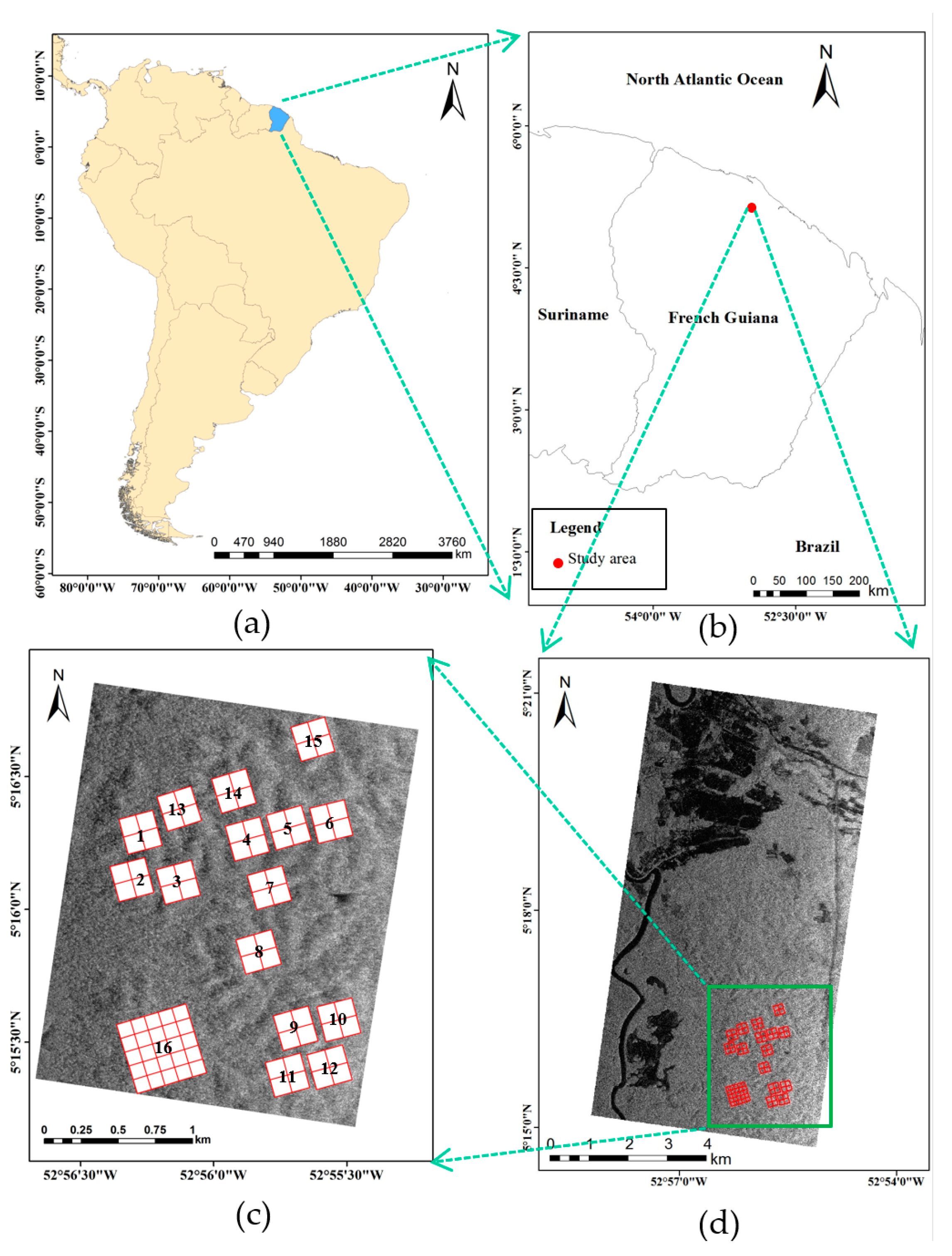
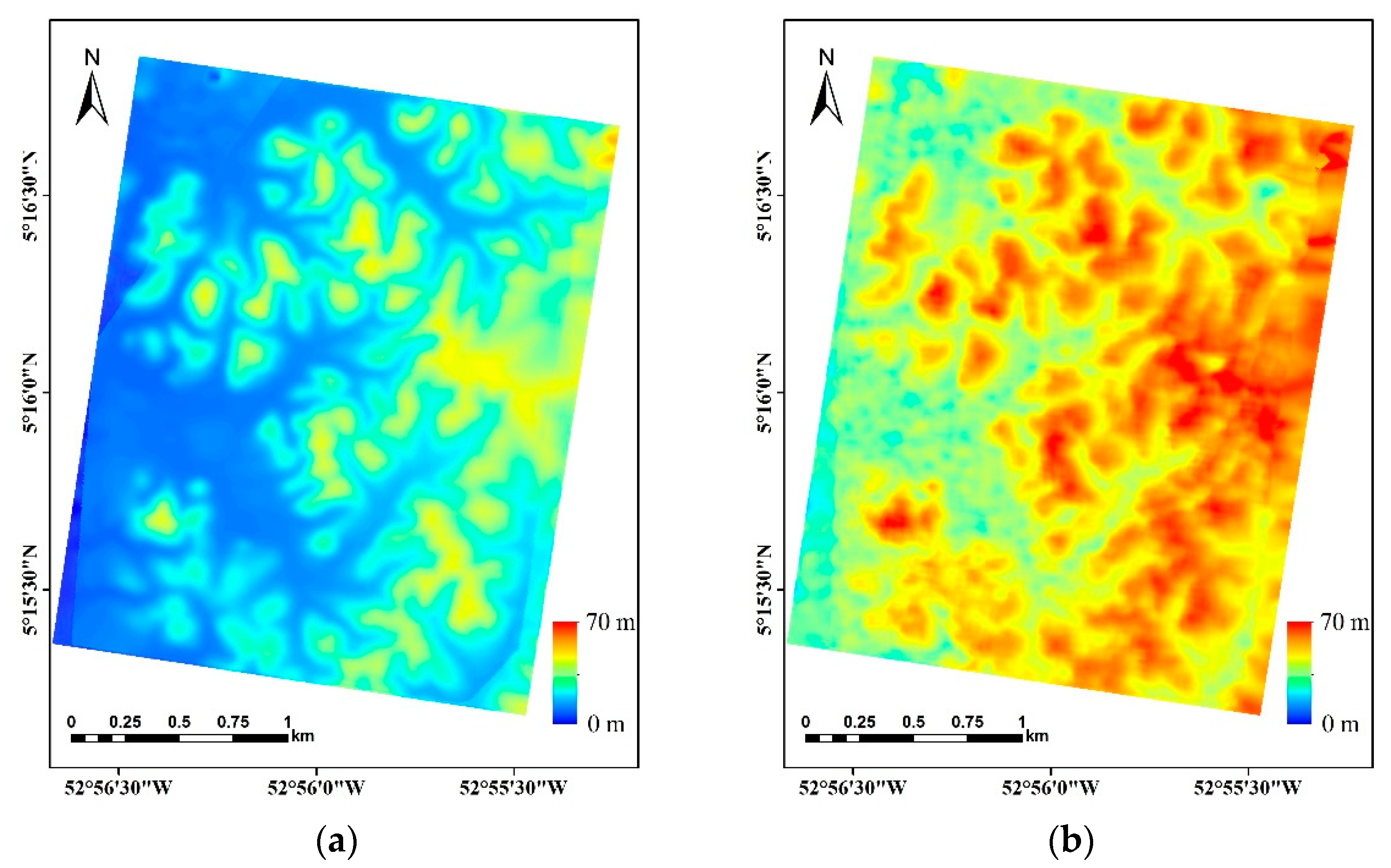


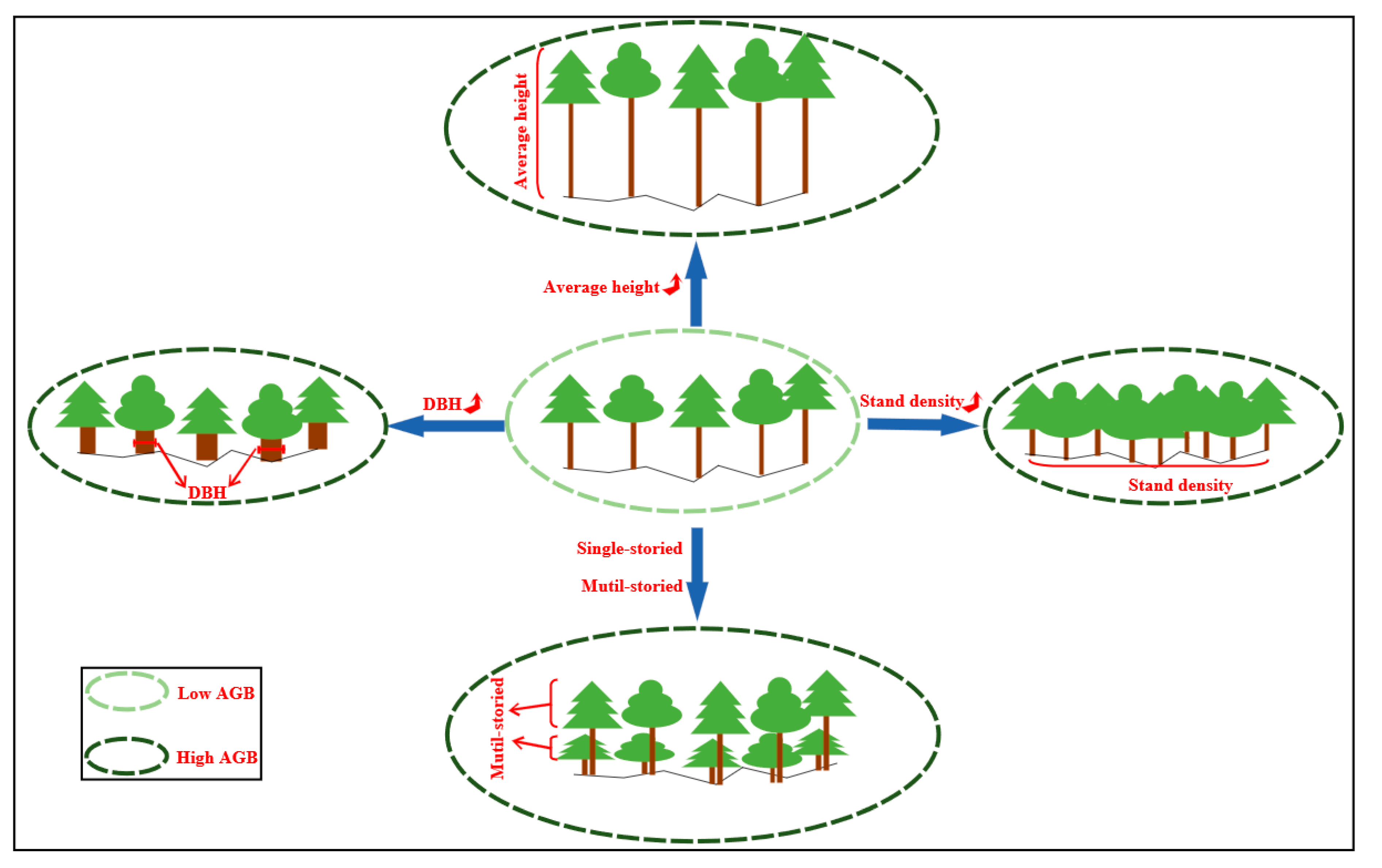
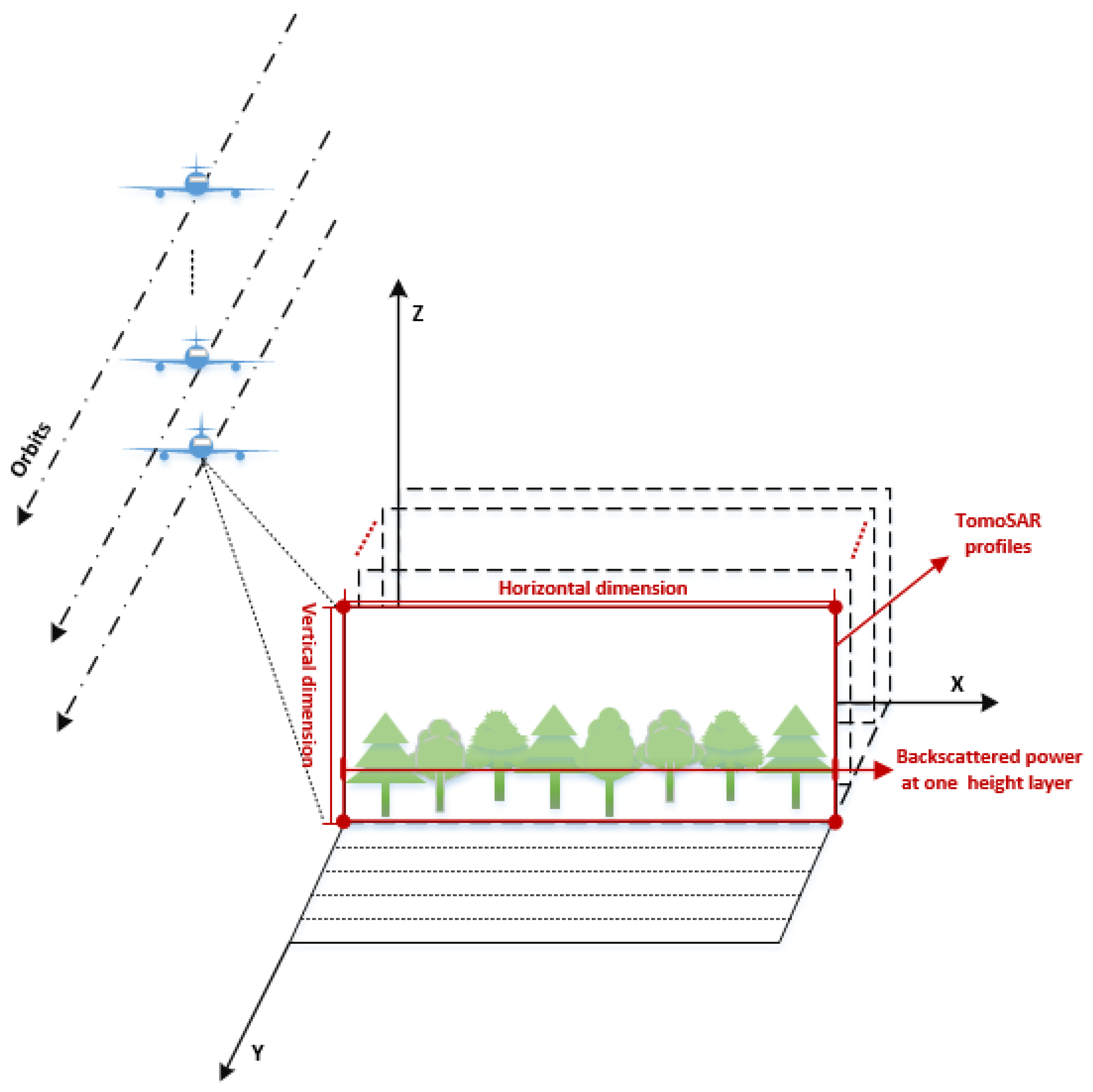

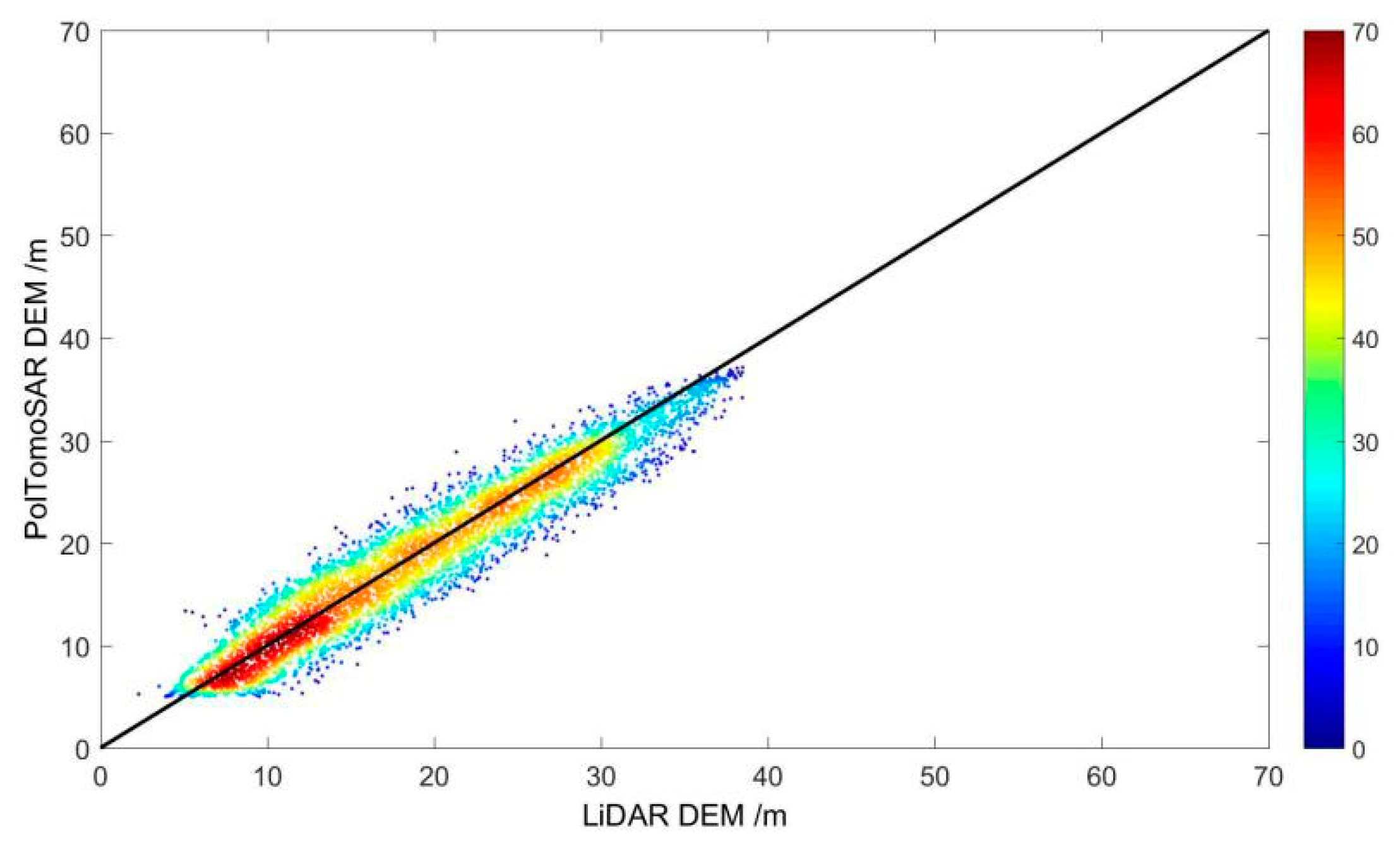
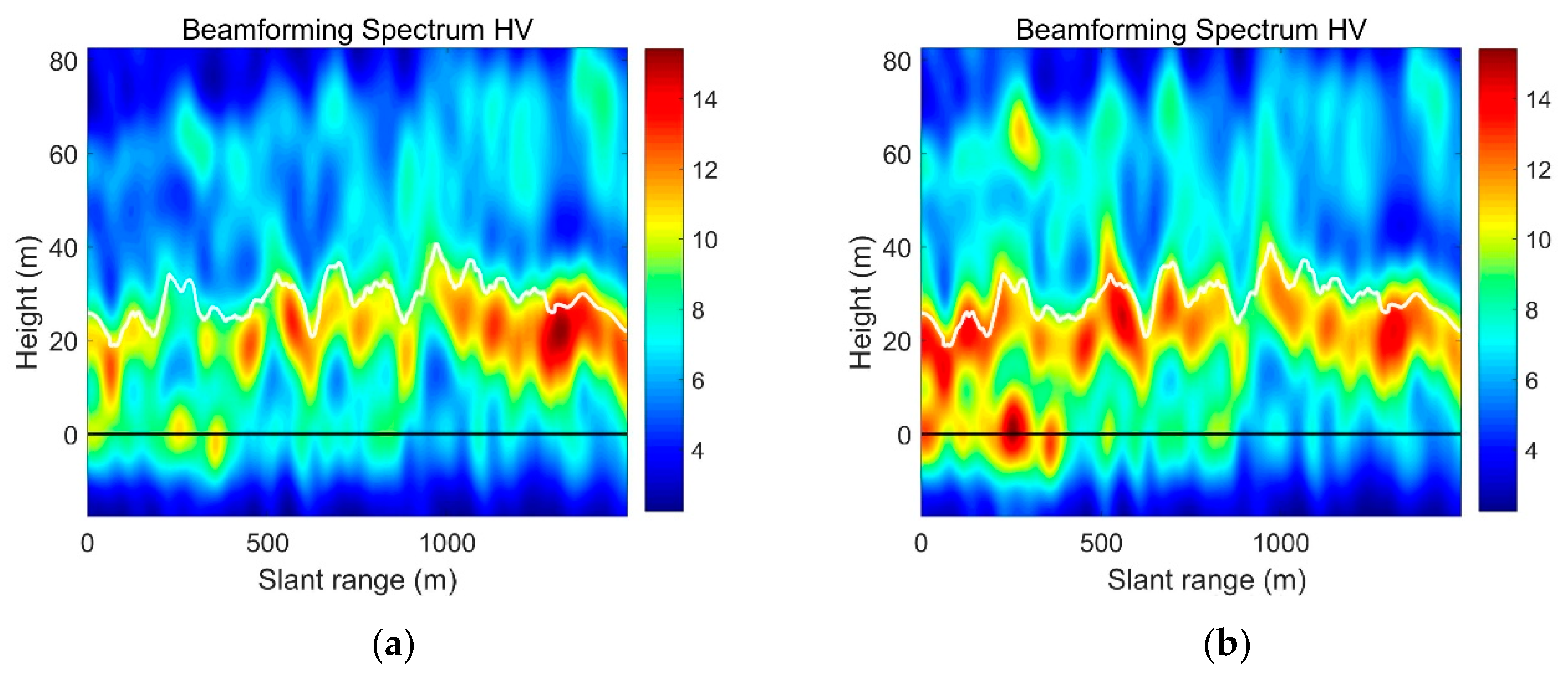
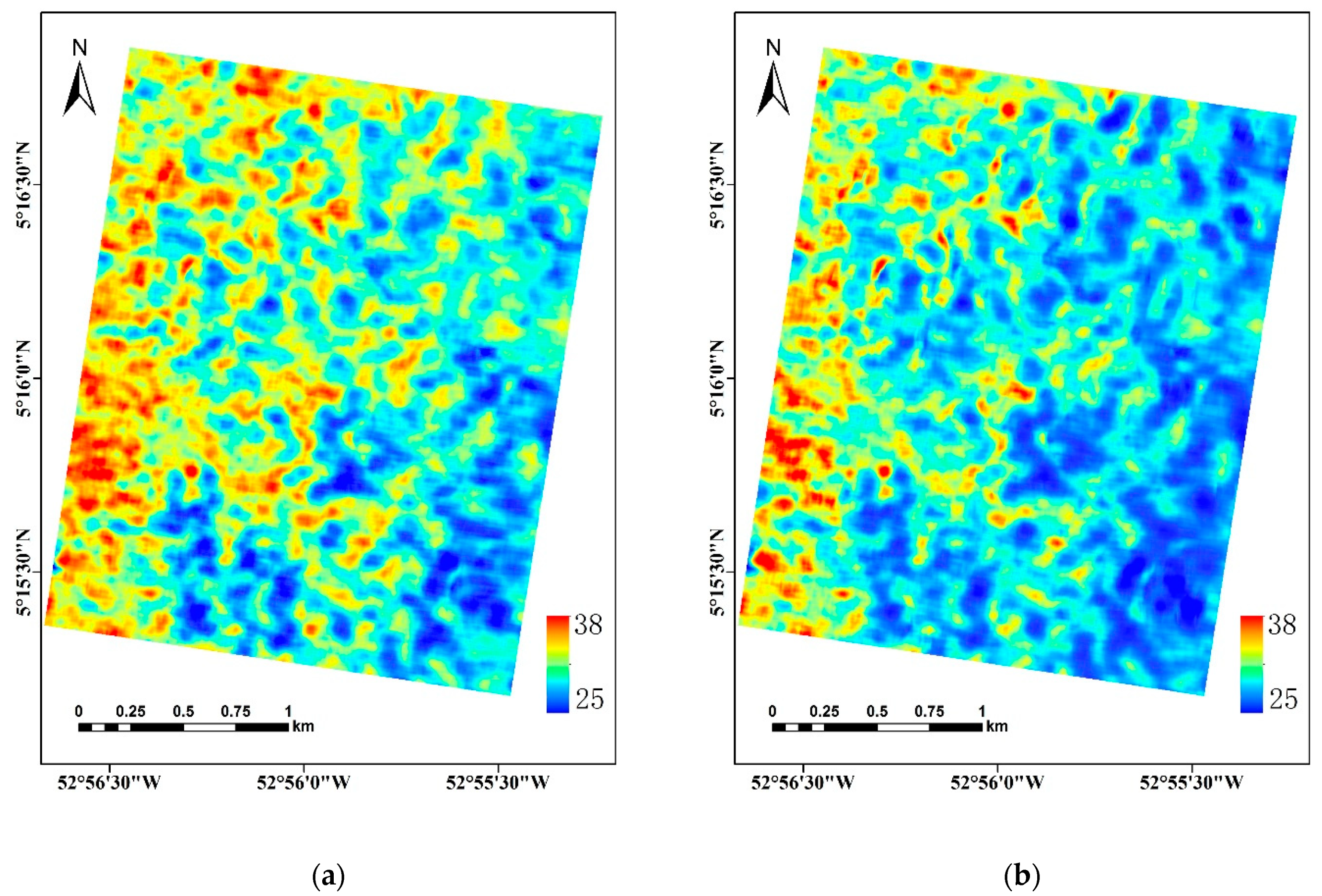
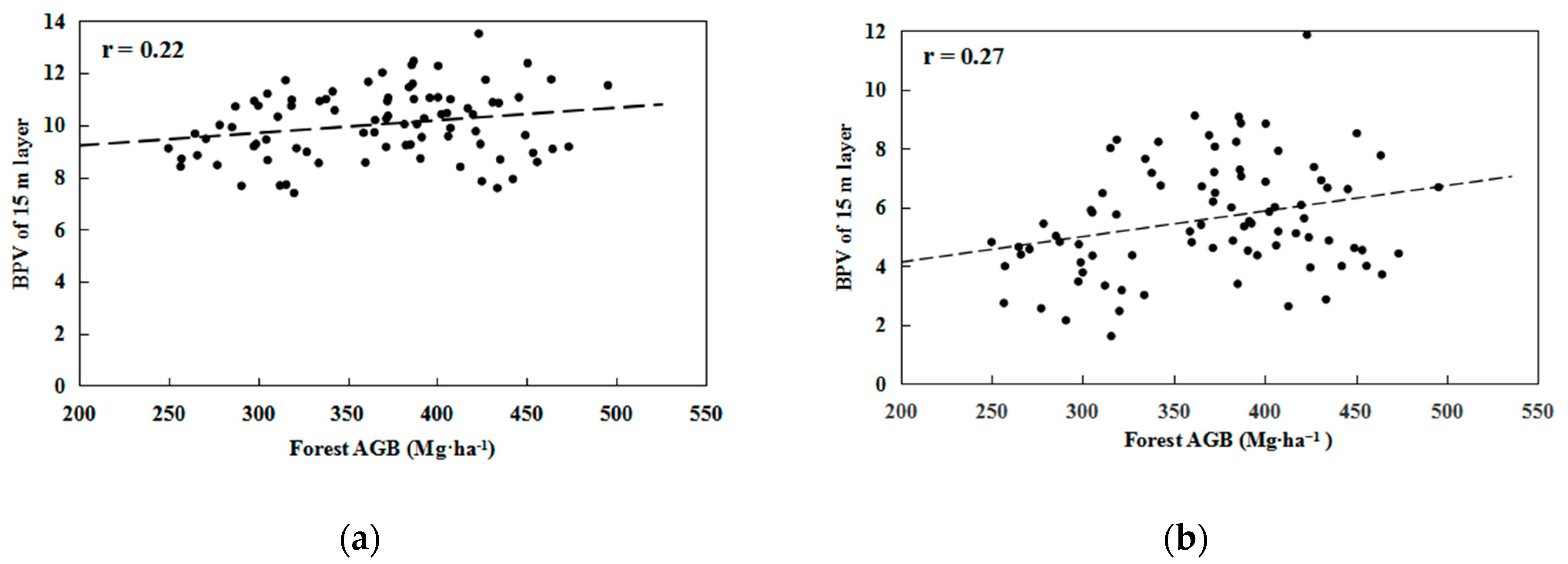

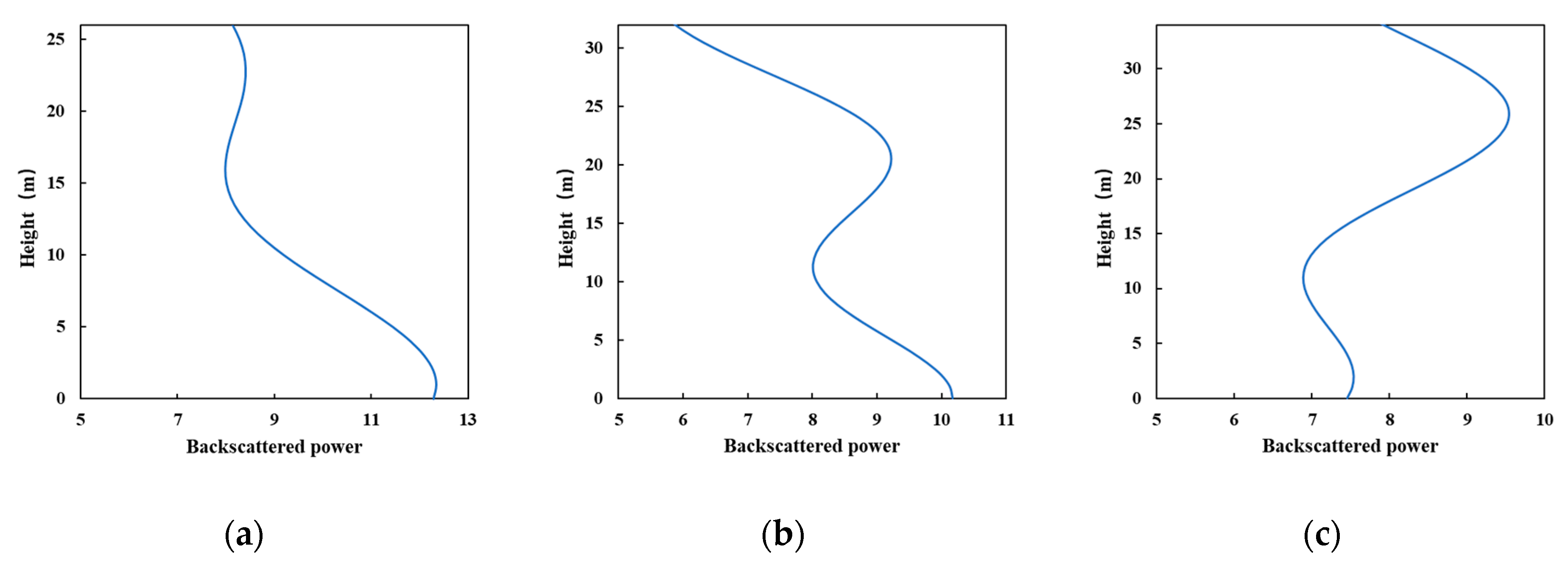

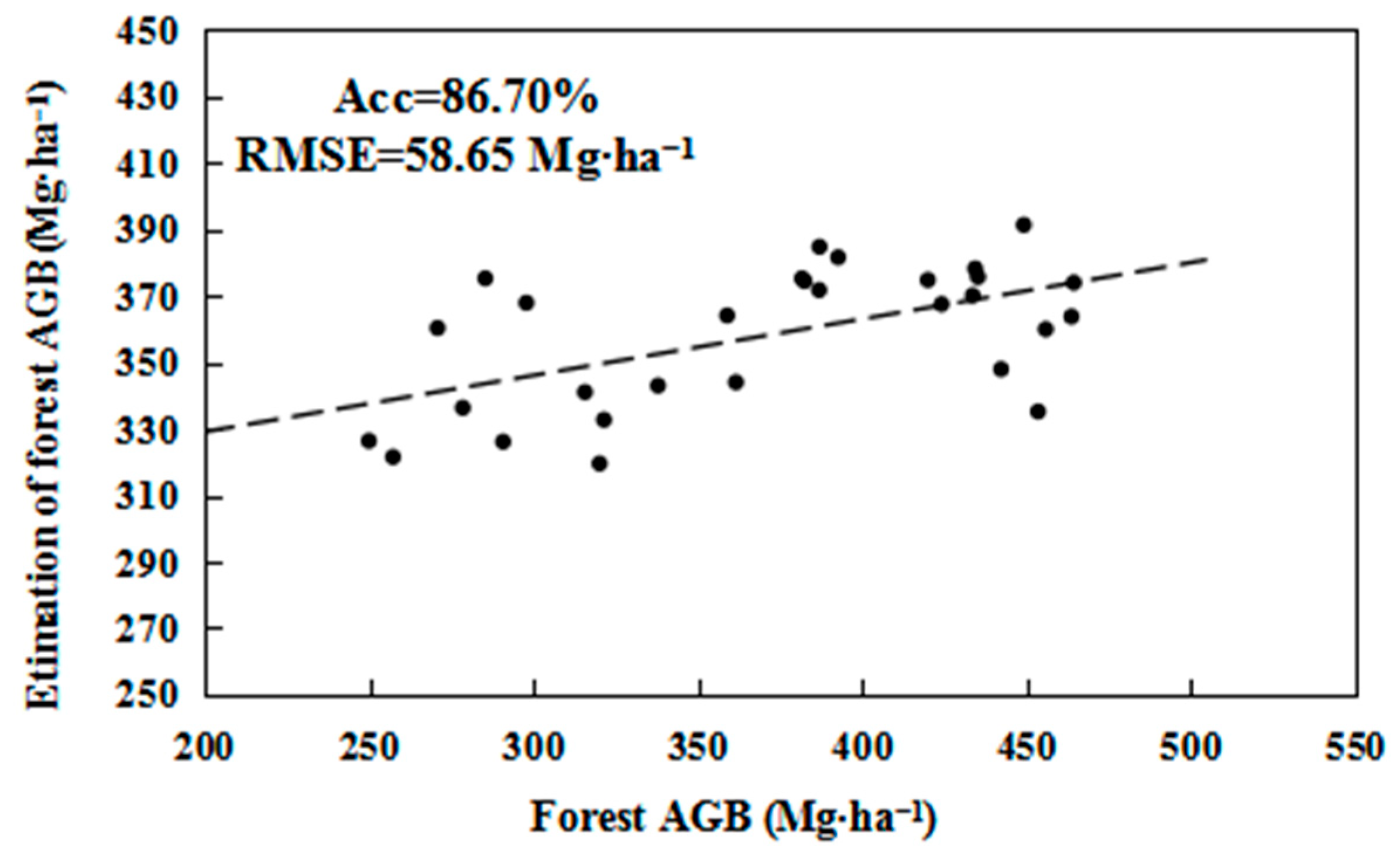
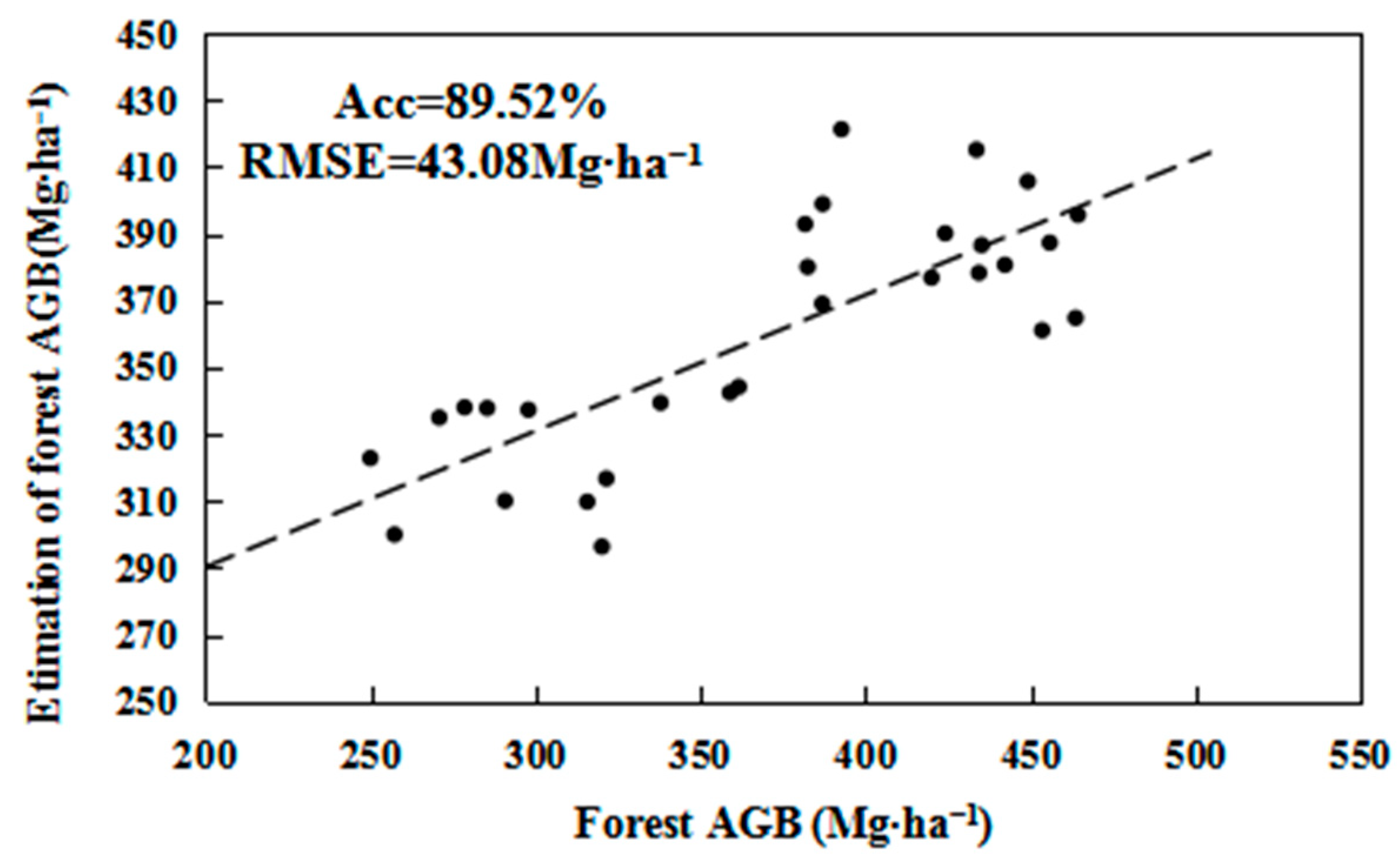
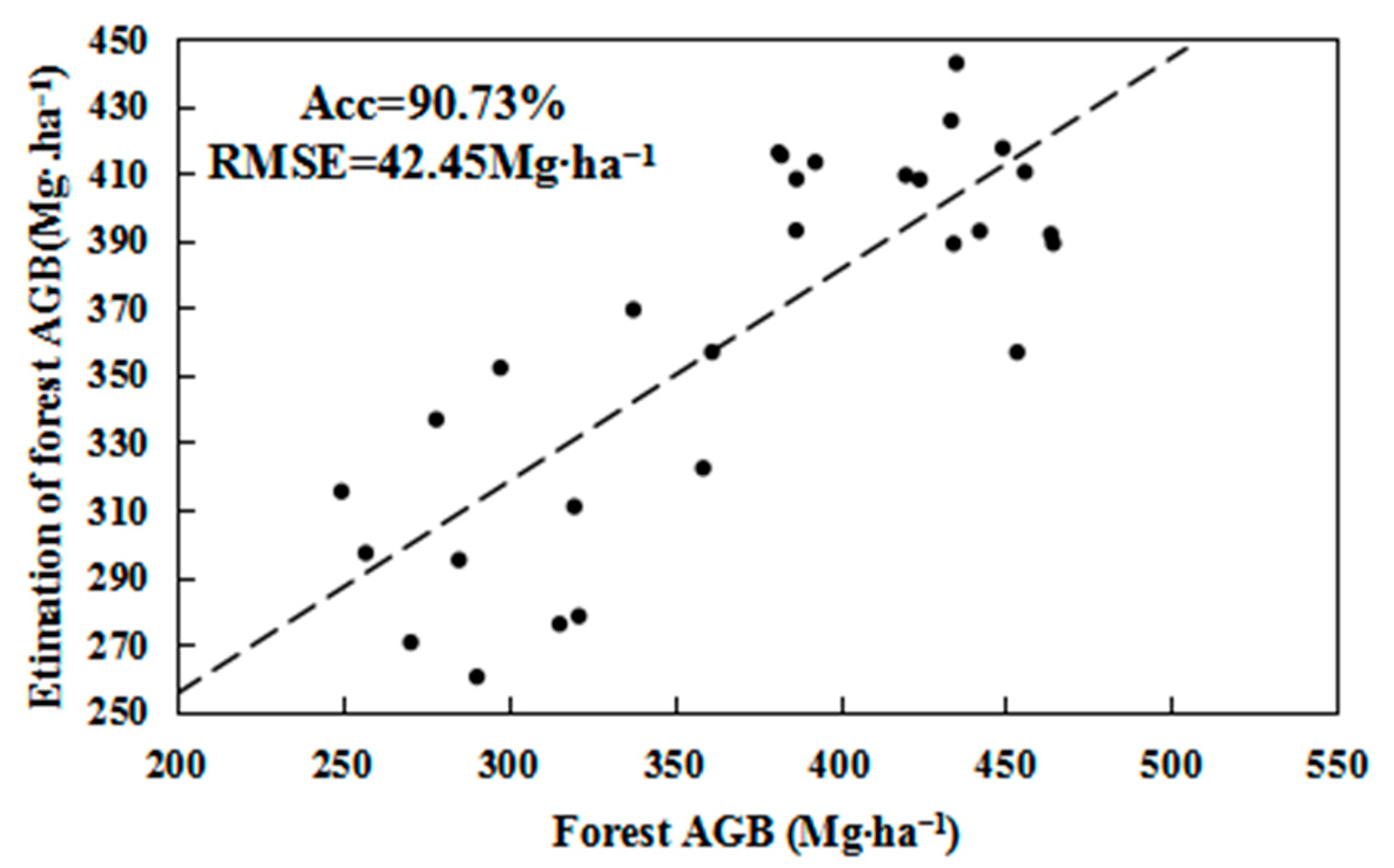
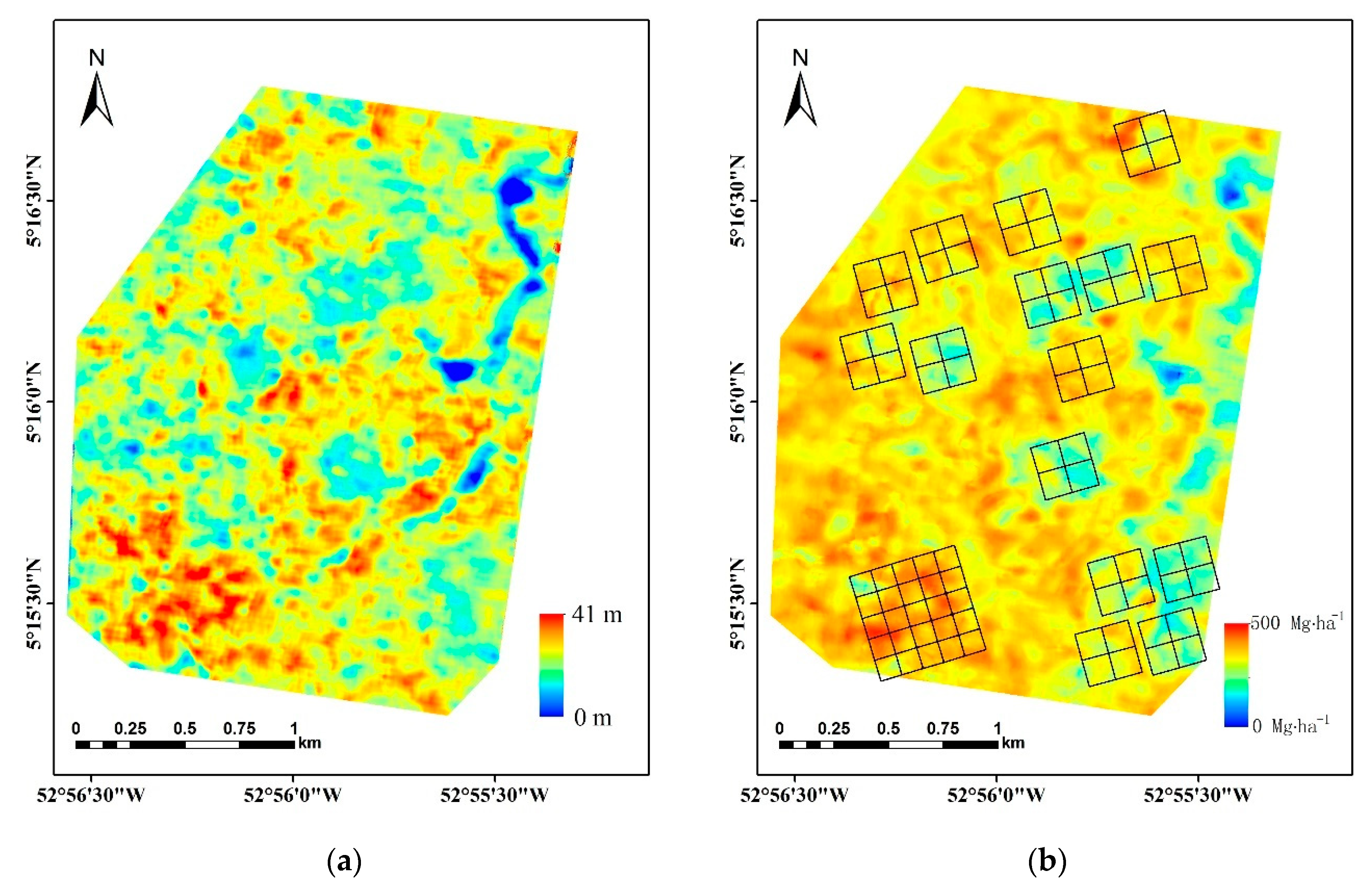
| Parameter | Value |
|---|---|
| Flight passes | 6 |
| Time baseline [h] | 2 |
| Bandwidth [MHz] | 335~460 |
| Altitude of reference flight line [m] | 3962 |
| Space baseline [m] | 15 |
| Azimuth resolution [m] | 1.2 |
| Range resolution [m] | 1.0 |
| Incident angle range [°] | 19~52 |
| Sub Plot No. | Forest AGB (Mg∙ha−1) | Sub Plot No. | Forest AGB (Mg∙ha−1) | Sub Plot No. | Forest AGB (Mg∙ha−1) |
|---|---|---|---|---|---|
| 1 | 315.23 | 30 | 257.24 | 59 | 434.35 |
| 2 | 341.52 | 31 | 265.99 | 60 | 430.95 |
| 3 | 372.59 | 32 | 256.70 | 61 | 359.84 |
| 4 | 449.15 | 33 | 327.13 | 62 | 424.98 |
| 5 | 334.66 | 34 | 337.86 | 63 | 392.67 |
| 6 | 310.92 | 35 | 365.02 | 64 | 407.41 |
| 7 | 318.69 | 36 | 320.09 | 65 | 419.96 |
| 8 | 421.61 | 37 | 277.15 | 66 | 390.67 |
| 9 | 304.49 | 38 | 297.58 | 67 | 455.83 |
| 10 | 285.31 | 39 | 333.78 | 68 | 372.16 |
| 11 | 358.88 | 40 | 321.43 | 69 | 435.19 |
| 12 | 287.34 | 41 | 405.47 | 70 | 402.44 |
| 13 | 297.81 | 42 | 385.09 | 71 | 473.52 |
| 14 | 305.31 | 43 | 407.40 | 72 | 342.81 |
| 15 | 270.79 | 44 | 412.93 | 73 | 424.14 |
| 16 | 264.79 | 45 | 312.17 | 74 | 406.25 |
| 17 | 318.51 | 46 | 315.63 | 75 | 371.43 |
| 18 | 300.01 | 47 | 298.85 | 76 | 433.59 |
| 19 | 305.21 | 48 | 290.73 | 77 | 365.39 |
| 20 | 278.46 | 49 | 400.48 | 78 | 382.44 |
| 21 | 495.42 | 50 | 385.71 | 79 | 371.51 |
| 22 | 463.65 | 51 | 384.36 | 80 | 442.23 |
| 23 | 395.89 | 52 | 450.56 | 81 | 453.50 |
| 24 | 372.69 | 53 | 445.56 | 82 | 391.43 |
| 25 | 369.41 | 54 | 400.37 | 83 | 381.65 |
| 26 | 426.96 | 55 | 423.16 | 84 | 386.99 |
| 27 | 386.24 | 56 | 361.57 | 85 | 464.37 |
| 28 | 386.87 | 57 | 388.68 | ||
| 29 | 249.90 | 58 | 417.14 |
| Features | Feature Calculation Method | Description of Features |
|---|---|---|
| FAH | Taking the DTM extracted by TomoSAR as the ground height and DSM as the height of forest canopy , the forest average height , was obtained through their difference, which mainly reflected the average height of each sample plot. | |
| LBPC | The total length L of the backscattered power curve was obtained by integrating the length of the backscattered power curve in the vertical dimension. The parameter L can reflect the forest structure information such as multi-storied forest and the average forest height. | |
| BPV | The average height of the forest was rounded, and backscattered power value of 0 m, 1 m, 2 m......m height layers were extracted from the TomoSAR vertical profile. The backscattered power values reflect the information of stand density and average DBH of sample plot. | |
| BPFAH | Taking the ratio of each sampling height layers backscattered power to the sum of backscattered power for weight assignment. Then the weighted average height of forest can be computed, which can reflect the information of the stand density, the forest average height and DBH of the plots. |
| Features | BPV-5 | BPV-31 | FAH | BPFAH | LBPC |
|---|---|---|---|---|---|
| BPV-5 | 1 | −0.45 | −0.84 | −0.88 | −0.67 |
| BPV-31 | −0.45 | 1 | 0.51 | 0.73 | 0.44 |
| FAH | −0.84 | 0.51 | 1 | 0.85 | 0.85 |
| BPFAH | −0.88 | 0.73 | 0.85 | 1 | 0.72 |
| LBPC | −0.67 | 0.44 | 0.85 | 0.72 | 1 |
Publisher’s Note: MDPI stays neutral with regard to jurisdictional claims in published maps and institutional affiliations. |
© 2021 by the authors. Licensee MDPI, Basel, Switzerland. This article is an open access article distributed under the terms and conditions of the Creative Commons Attribution (CC BY) license (http://creativecommons.org/licenses/by/4.0/).
Share and Cite
Wan, X.; Li, Z.; Chen, E.; Zhao, L.; Zhang, W.; Xu, K. Forest Aboveground Biomass Estimation Using Multi-Features Extracted by Fitting Vertical Backscattered Power Profile of Tomographic SAR. Remote Sens. 2021, 13, 186. https://doi.org/10.3390/rs13020186
Wan X, Li Z, Chen E, Zhao L, Zhang W, Xu K. Forest Aboveground Biomass Estimation Using Multi-Features Extracted by Fitting Vertical Backscattered Power Profile of Tomographic SAR. Remote Sensing. 2021; 13(2):186. https://doi.org/10.3390/rs13020186
Chicago/Turabian StyleWan, Xiangxing, Zengyuan Li, Erxue Chen, Lei Zhao, Wangfei Zhang, and Kunpeng Xu. 2021. "Forest Aboveground Biomass Estimation Using Multi-Features Extracted by Fitting Vertical Backscattered Power Profile of Tomographic SAR" Remote Sensing 13, no. 2: 186. https://doi.org/10.3390/rs13020186
APA StyleWan, X., Li, Z., Chen, E., Zhao, L., Zhang, W., & Xu, K. (2021). Forest Aboveground Biomass Estimation Using Multi-Features Extracted by Fitting Vertical Backscattered Power Profile of Tomographic SAR. Remote Sensing, 13(2), 186. https://doi.org/10.3390/rs13020186








